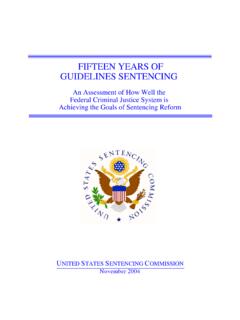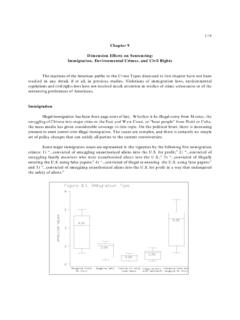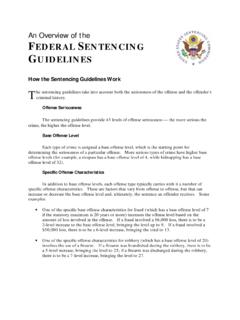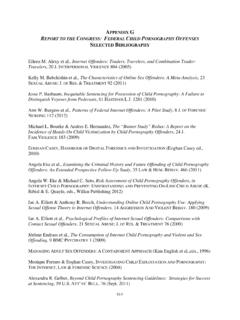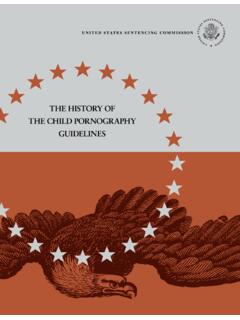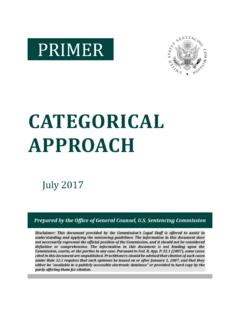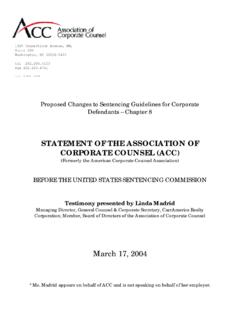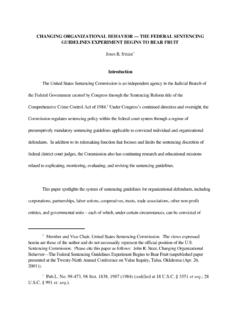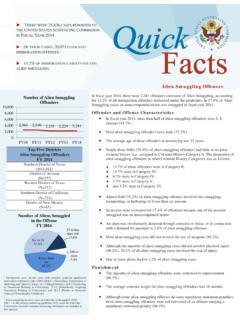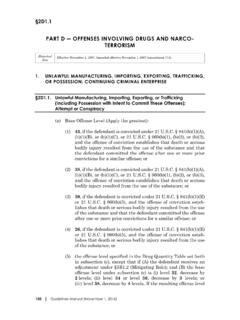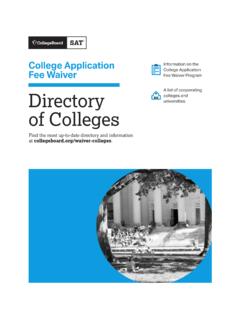Transcription of Quick Facts on Felons in Possession of a Firearm
1 OF THESE CASES, 5,768 INVOLVEDCONVICTIONS UNDER 18 922(g).1 THERE WERE 84,173 CASES REPORTED TOTHE UNITED STATES SENTENCING COMMISSION IN FISCAL YEAR 2012. 6,0105,76802,0004,0006,0008,00010,000FY2 008FY 2012 Numbe r o f Fe lon in Pos session o f a Fire arm Offe nde rsTop Five Districts Felon in Possession of a Firearm FY 2012 western district of missouri (N=187) western district of Texas (N=186) Middle district of Florida (N=174) Northern district of Ohio (N=164) Southern district of Texas (N=157) Unlawful Receipt, P ossession, or Transportation of Firearms or Ammunitions, , Other Guidelines, Se nte ncing Guide line Fe lon in Possession of a Fire arm3FY 2012 in Possession of a Firearm1 Offender and Offense Characteristics In fiscal year 2012, 5,768 offenders were convicted of violating18 922(g).
2 Nearly all of these offenders were male ( ). About half of these offenders were Black ( ), followed by White ( ),Hispanic ( ), and Other Races ( ). The average age of these offenders at sentencing was 33 years. The majority of these offenders were United States citizens ( ). One-quarter ( ) of offenders convicted under section 922(g) were assignedto the highest criminal history category (Category VI). The proportion of theseoffenders in other Criminal History Categories was as follows: of these offenders were in Category I; were in Category II; were in Category III; were in Category IV; and were in Category V.
3 Districts with the highest proportion of their overall caseload comprisingsection 922(g) offenses were: Middle district of North Carolina ( of the overall caseload); Northern district of Alabama ( ); western district of Tennessee ( ); western district of missouri ( ); and Southern district of Georgia ( ).Punishment Most offenders convicted under 18 922(g) were sentenced toimprisonment ( ). Less than one-quarter ( ) of these offenders were convicted of one or morestatutes carrying a mandatory minimum penalty: were sentenced under the Armed Career Criminal Act (ACCA)(18 924(e));2 another were convicted of violating 18 924(c); and another were convicted of another statute carrying a mandatory minimum penalty (almost all of which were drug offenses).
4 The average sentence imposed on section 922(g) offenders varied widely bywhether a mandatory minimum penalty applied in the 18 922(g) prohibits certain persons from shipping, transport-ing, possessing, or receiving a Firearm or ammunition while subject to a prohibition from doing so, most commonly because of a prior conviction for a felony offense. 2 18 924(e) requires a 15-year mandatory minimum penalty be imposed on offenders convicted of violating section 922(g) and who have three previous convictions for a violent felony or serious drug crime. 3 In of all cases involving a conviction for section 922(g), the offender was also convicted of a non-firearms offense where the sentenc-ing guideline applicable to the other offense was the primary guideline the court applied at sentencing.
5 QQQuiuiuiccckkk FactsFactsFacts Subst ant ial Assist ance57 .2% her Gov't rnme nt SponsoredBe low Range SentencesFY 2012050100150FY2008FY2009FY2010FY2011FY2 012 Ave rage Sentence and Ave rage Guide line Minimum (in months)Sen tenceGu ideline M in imu mFelon in Possession of a Firearm1 nte nce Relative to the Guide line RangeWithinAb oveGo v't Spons. BelowOth er Belo w one Columbus Circle, Suite 2-500, South Lobby Washington, DC 20002-8002 T: (202) 502-4500 F: (202) 502-4699 For other Quick Facts publications, visit our website at 4 Early Disposition Program (or EDP) departures represent cases in which the government sought a sentence below the guideline range because the defendant participated in the government s Early Disposition Program, through which cases are resolved in an expedited manner.
6 SOURCE: United States Sentencing Commission, 2008 through 2012 Datafiles, USSCFY08-USSCFY12. Punishment (continued) The average sentence length for all section 922(g) offenders was 75 months; however, one-quarter of these offenders had an average sentence of 24 months or less while one-quarter had an average sentence of 96 months or more. The average sentence length for offenders convicted of violating only section 922(g) and who were sentenced under ACCA was 180 months. The average sentence length for offenders convicted of violating only section 922(g) but who were not sentenced under ACCA was 46 months.
7 Sentences Relative to the Guideline Range For each of the past five years, more than sixty percent of offenders convicted of violating 18 922(g) were sentenced within the range. However, the rate of within range sentences has decreased from in fiscal year 2008 to in fiscal year 2012. The rate of government sponsored below range sentences has increased for section 922(g) offenses from in fiscal year 2008 to in fiscal year 2012. In cases where the offender was not convicted of an additional offense and was not sentenced under ACCA, the rate of government sponsored sentences was higher, at in fiscal year 2012.
8 Substantial assistance departures were granted in of all section 922(g) cases in fiscal year 2012. This represents of all government sponsored below range sentences for these offenses. In fiscal year 2012, these offenders received an average reduction of in their sentences. In fiscal year 2012, a smaller proportion ( ) of offenders convicted of violating section 922(g) received a below range sentence sponsored by the government for reasons other than substantial assistance or participation in an Early Disposition Program. In fiscal year 2012, these offenders received an average reduction of in their sentences.
9 Over the last five years, the rate of non-government sponsored below range sentences for section 922(g) offenses has increased (from in fiscal year 2008 to in fiscal year 2012). In fiscal year 2012, these offenders received an average reduction of in their sentences. The average guideline minimum for section 922(g) offenses has decreased for the past five years, and the average sentence imposed has similarly decreased. The average guideline minimum decreased from 88 to 82 months during that period; The average sentence imposed decreased from 82 to 75 months.
10 QQQuiuiuiccckkk FactsFactsFacts
